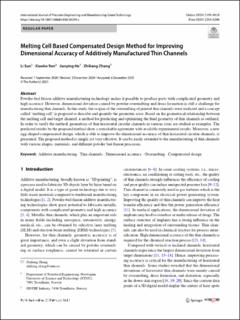| dc.contributor.author | Sun, Li | |
| dc.contributor.author | Ren, Xiaobo | |
| dc.contributor.author | He, Jianying | |
| dc.contributor.author | Zhang, Zhiliang | |
| dc.date.accessioned | 2021-02-25T08:32:59Z | |
| dc.date.available | 2021-02-25T08:32:59Z | |
| dc.date.created | 2020-12-06T22:37:09Z | |
| dc.date.issued | 2020 | |
| dc.identifier.issn | 2288-6206 | |
| dc.identifier.uri | https://hdl.handle.net/11250/2730258 | |
| dc.description.abstract | Powder-bed fusion additive manufacturing technology makes it possible to produce parts with complicated geometry and high accuracy. However, dimensional deviation caused by powder overmelting and dross formation is still a challenge for manufacturing thin channels. In this study, we analyzed the origins of the overmelting of printed thin channels and propose a concept called "melting cell" to describe and quantify the geometric error. Based on the geometrical relationship between the melting cell and target channel, a method for predicting and optimizing the final geometry of thin channels is outlined. In order to verify the method, geometries of thin horizontal circular channels of various sizes are studied as examples. The predicted results by the proposed method show a remarkable agreement with available experimental results. Moreover, a mathematical description of the compensated design of a thin channel is also presented. The proposed method is simple yet effective. It can be easily extended to manufacturing of thin channels with various shapes, materials, and different powder bed fusion processes. | en_US |
| dc.language.iso | eng | en_US |
| dc.publisher | Springer | en_US |
| dc.rights | Navngivelse 4.0 Internasjonal | * |
| dc.rights.uri | http://creativecommons.org/licenses/by/4.0/deed.no | * |
| dc.title | Melting cell based compensated design method for improving dimensional accuracy of additively manufactured thin channels | en_US |
| dc.type | Peer reviewed | en_US |
| dc.type | Journal article | en_US |
| dc.description.version | publishedVersion | en_US |
| dc.source.journal | International Journal of Precision Engineering and Manufacturing - Green Technology | en_US |
| dc.identifier.doi | https://doi.org/10.1007/s40684-020-00299-z | |
| dc.identifier.cristin | 1856647 | |
| dc.relation.project | Norges forskningsråd: 281927 | en_US |
| dc.relation.project | Norges forskningsråd: 269558 | en_US |
| dc.description.localcode | Open Access. This article is licensed under a Creative Commons Attribution 4.0 International License, which permits use, sharing, adaptation, distribution and reproduction in any medium or format, as long as you give appropriate credit to the original author(s) and the source, provide a link to the Creative Commons licence, and indicate if changes were made. The images or other third party material in this article are included in the article’s Creative Commons licence, unless indicated otherwise in a credit line to the material. If material is not included in the article’s Creative Commons licence and your intended use is not permitted by statutory regulation or exceeds the permitted use, you will need to obtain permission directly from the copyright holder. To view a copy of this licence, visit http://creat iveco mmons .org/licen ses/by/4.0/. | en_US |
| cristin.ispublished | false | |
| cristin.fulltext | postprint | |
| cristin.fulltext | original | |
| cristin.qualitycode | 1 | |

